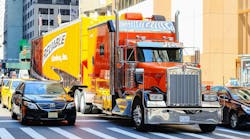In my last post, I mentioned the fuel savings that could be realized by driver assistance features, such as cruise control with braking and stop/start capability. This is where a vehicle uses its radar system, brakes, and driver assistance cruise controls to keep a safe distance from the vehicle in front, even when the vehicle slows down to a crawl. Only if it stops (in my 2010 Mercedes vehicle) do I have to touch the accelerator pedal to restart the vehicle. I’d like to take this thought a couple of steps further.
I went to downtown Portland yesterday in rush hour. A twenty minute trip in good traffic took me almost 50 minutes at dinner time. I regularly sidle up to the vehicle in front of me, leaving just a few feet. I noticed other lanes where drivers were leaving as much as 2 car lengths between them and the vehicle in front of them. That contributes to the congestion and wasted time I had to deal with.
A vehicle with the technology we discuss for autonomous vehicles, would be more likely to shorten that distance. An autonomous technology-based driver assistance feature that I might call “AutoCongestionRelief” would go further than my vehicle does today. It would allow the vehicle to come to a complete stop, and turn off the engine to save fuel. It would sense when the vehicle in front starts moving and, perhaps with a warning to me, would automatically start back up, keeping a short distance to the next vehicle that is still quite safe. The stopping distance of a vehicle at a few miles per hour in congested, rush-hour traffic is pretty good. I would think it much safer to do that than try to deal with a vehicle going 60 miles per hour or better.
With such a feature, we would all save fuel and time. I can imagine taking this concept to a truck in congested traffic. The loaded truck cannot accelerate as fast as the car in front of it, but it does have plenty of brake capability at slow speed. A conventional truck may have trouble seeing the rear end of the vehicle in front of it, but the radar/lidar/ultrasonic/camera sensors could have a good idea of where it is and how far in front of the truck. This could be a good case for government to require some technology on new cars and trucks. It would save fuel and time for everyone. It could further improve safety, since accidents do occur in congested traffic that further congests the traffic.
No need to get rid of the driver in this case. There is a payback in fuel cost, congestion reduction, time saved, and accidents reduced. We might not be ready to relinquish control of the vehicle and get rid of the driver. But I’d not mind being able to do something else in congested traffic while my vehicle was able to GO More—STOP Less.


